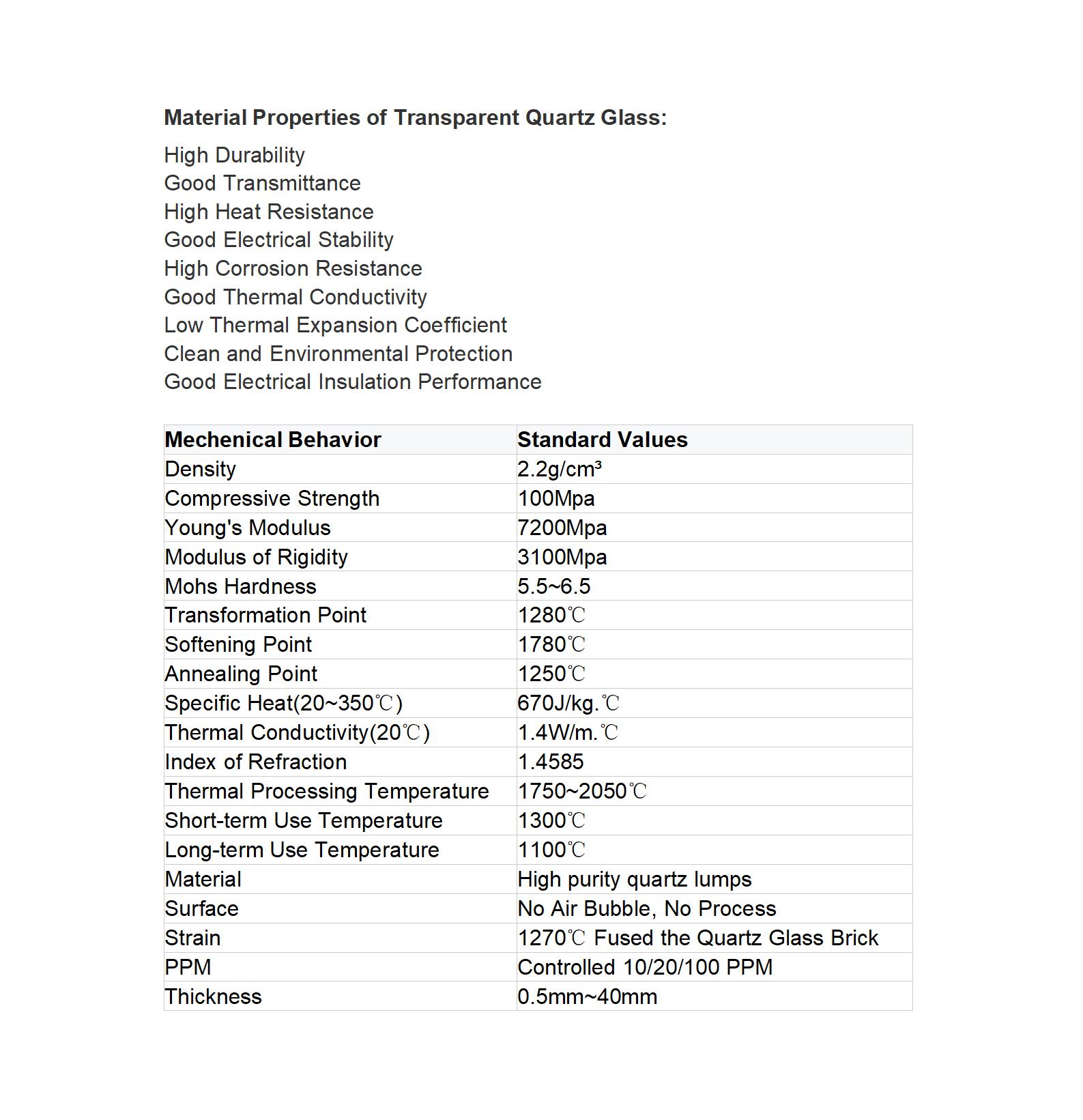T: +86-518-85528012
E: nick@luverrequartz.com
E: nick@luverrequartz.com
1st floor Runlian industrial center No. 116 QuFeng Rd., Haizhou Economic and technological development zone Lianyungang City, Jiangsu Province, China 222062
Chemistry laboratory 3-300mmOd quartz glass tube
In chemical laboratories, quartz glass tubes with an outer diameter of 3-300mm are a common type of experimental equipment made of high-purity silica (SiO2).
LUVERRE quartz
99.99%
Inner with Vacuum PVC bag and then wrapped with air bubble film, outer with wooden box.
as per customer's requirement
| Availability: | |
|---|---|
Chemistry laboratory 3-300mmOd quartz glass tube
In chemical laboratories, quartz glass tubes with an outer diameter of 3-300mm are a common type of experimental equipment made of high-purity silica (SiO2). This type of quartz glass tube is widely used in various experimental environments due to its excellent physical and chemical properties, especially those requiring high temperature resistance, corrosion resistance, and optical transparency.
Material characteristics
- High purity: Quartz glass tubes are usually composed of more than 99.9% silica, ensuring their purity and thus reducing the influence of impurities on experimental results.
-Thermal stability: Quartz glass has a very low coefficient of thermal expansion, allowing it to maintain dimensional stability over a wide temperature range, making it suitable for experiments under high temperature conditions.
- Chemical inertness: With the exception of a few strong acids such as hydrofluoric acid (HF) and phosphoric acid (H3PO4), quartz glass is virtually immune to attack from other chemicals, making it ideal for use as a reaction vessel or as a pipe for conveying corrosive substances.
-Optically transparent: High-purity quartz glass exhibits good light transmission in the ultraviolet to infrared wavelength range, making it suitable for spectroscopic analysis and other optical measurement experiments.

Specifications and dimensions
- Outer diameter (Od) range: from 3mm to 300mm, to meet the needs of different application scenarios. According to the specific application requirements, the appropriate size of quartz glass tube can be selected.
-Wall thickness: Under normal circumstances, the wall thickness will increase as the outer diameter increases to ensure sufficient mechanical strength and safety.
Length: Quartz glass tubes of different lengths can be customized according to the specific needs of customers, and standard products also offer a variety of length options.
Application field
Chemical synthesis: as part of a reactor or distillation unit, especially for processes involving high-temperature or corrosive chemicals.
Analytical instruments such as chromatographic columns, sample cells in spectrometers, etc., take advantage of their excellent optical properties.
Semiconductor manufacturing: used as components in diffusion furnaces, chemical vapor deposition (CVD) equipment, as they can withstand high temperatures and maintain cleanliness.
Vacuum systems: Due to their sealing and pressure resistance, they can be used to create high-vacuum environments.
Lighting industry: for example, support structures in halogen bulbs or lens assemblies in special lamps.

The 3-300mm outer diameter quartz glass tube is one of the indispensable tools in chemical laboratories. Its versatility and excellent performance make it the first choice for many researchers.
Chemistry laboratory 3-300mmOd quartz glass tube
In chemical laboratories, quartz glass tubes with an outer diameter of 3-300mm are a common type of experimental equipment made of high-purity silica (SiO2). This type of quartz glass tube is widely used in various experimental environments due to its excellent physical and chemical properties, especially those requiring high temperature resistance, corrosion resistance, and optical transparency.
Material characteristics
- High purity: Quartz glass tubes are usually composed of more than 99.9% silica, ensuring their purity and thus reducing the influence of impurities on experimental results.
-Thermal stability: Quartz glass has a very low coefficient of thermal expansion, allowing it to maintain dimensional stability over a wide temperature range, making it suitable for experiments under high temperature conditions.
- Chemical inertness: With the exception of a few strong acids such as hydrofluoric acid (HF) and phosphoric acid (H3PO4), quartz glass is virtually immune to attack from other chemicals, making it ideal for use as a reaction vessel or as a pipe for conveying corrosive substances.
-Optically transparent: High-purity quartz glass exhibits good light transmission in the ultraviolet to infrared wavelength range, making it suitable for spectroscopic analysis and other optical measurement experiments.

Specifications and dimensions
- Outer diameter (Od) range: from 3mm to 300mm, to meet the needs of different application scenarios. According to the specific application requirements, the appropriate size of quartz glass tube can be selected.
-Wall thickness: Under normal circumstances, the wall thickness will increase as the outer diameter increases to ensure sufficient mechanical strength and safety.
Length: Quartz glass tubes of different lengths can be customized according to the specific needs of customers, and standard products also offer a variety of length options.
Application field
Chemical synthesis: as part of a reactor or distillation unit, especially for processes involving high-temperature or corrosive chemicals.
Analytical instruments such as chromatographic columns, sample cells in spectrometers, etc., take advantage of their excellent optical properties.
Semiconductor manufacturing: used as components in diffusion furnaces, chemical vapor deposition (CVD) equipment, as they can withstand high temperatures and maintain cleanliness.
Vacuum systems: Due to their sealing and pressure resistance, they can be used to create high-vacuum environments.
Lighting industry: for example, support structures in halogen bulbs or lens assemblies in special lamps.

The 3-300mm outer diameter quartz glass tube is one of the indispensable tools in chemical laboratories. Its versatility and excellent performance make it the first choice for many researchers.